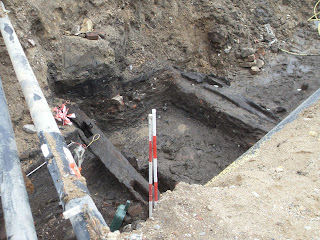In the city of Odense, Denmark, where I currently live, there is an ongoing excavation in the city-centre, and today there was an open day at the excavation area for the general public to have a look at some of the recent work. Naturally, I decided to go into town and have a look for myself.
Odense is an old settlement, and its name is first recorded in an imperial charter from 988, a time when Svein Tveskæg (Forkbeard) was king of Denmark. In this charter, Emperor Otto III accords privileges to the Danish bishoprics, and is commonly referred to as Odense's birth certificate. The city itself is much older, and recent archaeological excavations have shown that during the reign of Harald Blåtand (Bluetooth) (c.930-c.987) the city was an important royal centre with defensive ramparts. It was during the reign of Harald Blåtand that Denmark adopted Christianity after pressure from the German empire. This led to the establishment of the Danish bishoprics, and a recent excavation in Odense unearthed a bishop's tomb on the spot where the first church was built in the city. This church was made of wood and dedicated to Saint Alban, the English protomartyr. It was in this church that King Knud IV (Canute) was killed in 1086 following an uprising from the nobility and brought on mainly by excessive taxation. Knud was later translated to a new church and canonized in 1102. This church is the city's cathedral and was a Benedictine church in the Middle Ages.
From the 12th century onwards Odense was an important Danish city and this can be seen in some of the results from the ongoing excavations.

Area of the excavations. To the right, the new, Catholic St. Alban's church (1908)

To the left, the washing tent where the soil from the dig is examined
Much of the ongoing excavation is done outside what was once the bishop's palace (not pictured), and where there had been a cemetery in pre-Reformation times. In the washing tent (above) they have found many remnants from the late-medieval market square and from what is possibly the kitchen scraps from the dinners of several bishops. I popped by the tent and had a look, and only today they had discovered several nutshells, old bones and even fish scales. I was allowed to give the washing a try myself and I felt a distinctly boyish excitement as I was washing away the sand and could find several animal bones and fish scale as well.
In the pictures below we see a house which belonged to the guild of Our Lady in the 15th century. The guild itself was established around 1435, while the house is referred to in a textual document from the mid-fifteenth-century, and it is mentioned as belonging to the guild. The dating of the house itself is still not certain, since it is unknown whether the guild had the house built or whether the guildmen moved into a house that was already in place.
Below are some pictures from the excavated cemetery. The skeletons (see further below) are not yet dated, and an archaeologist at the scene told me that they could be from anywhere between 1000 and 1500.
In the pictures below we see the remnants of a wooden structure far deep in the loam. The archaeologists have suggested that it was a bridge that once crossed a moat built to protect the episcopal palace from attacks. This hypothesis is strengthened by the accounts from when the bishop's quarters were assaulted during the Reformation, when a party of attackers came down the river which runs right next to the palace, charged up to the palace itself and set fire to the doors. This was in the course of a brief civil war in Denmark which raged from 1534 to 36.

The supporting beams of the (probable) bishop's bridge

The light-brown, pointed surface is believed to show the remnants of a supporting structure, strengthening the idea of a bridge






















